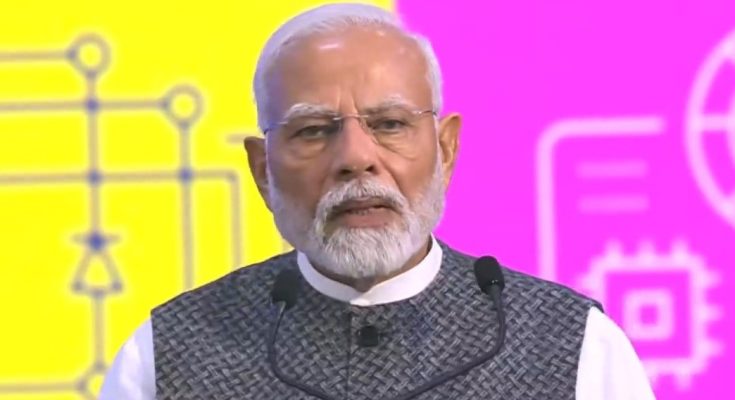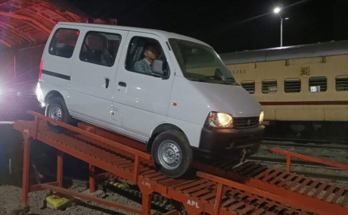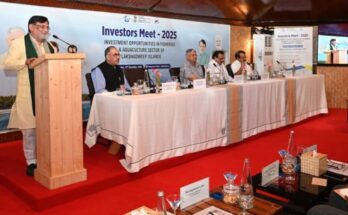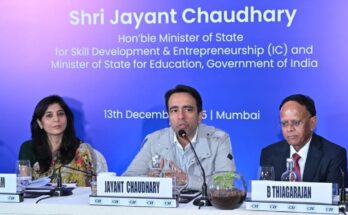SEMICON India 2024: The Prime Minister, Shri Narendra Modi inaugurated SEMICON India 2024 at India Expo Mart in Greater Noida, Uttar Pradesh today. Shri Modi took a walkthrough of the exhibition showcased on the occasion. The three-day conference from 11 to 13th September will showcase India’s semiconductor strategy and policy which envisions making India a global hub for semiconductors.
Addressing the gathering, the Prime Minister expressed gratitude to all members of SEMI saying that India is the eighth country in the world to organize an event related to the global semiconductor industry. “This is the right time to be in India. You are at the right place at the right time”, PM Modi emphasized, “In 21st-century India, the chips are never down.” He further added that the India of today assures the world, “When the chips are down, you can bet on India.”
Highlighting the connection between the semiconductor industry and a diode where energy traverses only in one direction, the Prime Minister said that India’s semiconductor industry is equipped with special diodes where energy flows in both directions. He explained that while industries invest and create value, the government on the other hand provides stable policies and Ease of Doing Business.
The Prime Minister said that India provides an integrated ecosystem drawing parallels with an integrated circuit used in the semiconductor industry and highlighted the much-discussed talent of India’s designers. Informing that India’s contribution to the world of designing is 20 percent and is growing continuously, PM Modi said that India is creating a semiconductor workforce of 85,000 technicians, engineers and R&D experts.
“India is focused on making its students and professionals industry ready”, the Prime Minister remarked, recalling the first meeting of the Anusandhan National Research Foundation which aims to give new direction and energy to India’s research ecosystem. He also mentioned a special research fund of Rs 1 trillion.
Prime Minister Modi underlined that such initiatives are bound to increase the scope of semiconductors and innovations in the science sector and also highlighted the government’s emphasis on semiconductor infrastructure. Explaining that India holds a three-dimensional power namely the present reformist government, the country’s growing manufacturing base and the nation’s aspirational market which is aware of the technological trends, the Prime Minister said that this base of 3D power is difficult to find elsewhere.
Highlighting the uniqueness of India’s aspirational and tech-oriented society, the Prime Minister said that the meaning of chips in India is not just limited to technology but is a medium to fulfill the aspirations of crores of citizens. Underlining that India is a huge consumer of such chips, PM Modi emphasized that the world’s finest digital public infrastructure was built upon it. “This small chip is doing big things to ensure last-mile delivery in India”, PM Modi said. Recalling the coronavirus crisis when the strongest banking systems of the world collapsed, Shri Modi said that banks in India were running continuously.
“Be it India’s UPI, Rupay Card, Digi Locker or Digi Yatra, multiple digital platforms have become a part of the everyday life of the people of India”, he noted. To become self-reliant, the Prime Minister said that India is increasing manufacturing in every sector, making green transition on a large scale and the demand for data centers is also increasing. “India is set to play a big role in driving the global semiconductor industry”, he added.
The Prime Minister said there is an old saying – ‘Let the chips fall where they may’, that means whatever is going on…let it go on like that but today’s young and aspirational India does not follow this sentiment, he added, saying that “India\’s new mantra is increasing the number of chips produced in India”. Pointing out the numerous steps taken by the government to promote semiconductor manufacturing, Shri Modi highlighted that the government is offering 50% financial support for setting up semiconductor manufacturing facilities, with state governments also playing a key role in this effort. Because of these policies, he said, India has attracted investments worth more than Rs 1.5 trillion in a very short time and many more projects are in the pipeline.
Shri Modi also shed light on the comprehensive approach of the Semicon India Program which provides financial support for front-end fabs, display fabs, semiconductor packaging and other critical components of the supply chain. “Our dream is that every device in the world will have an Indian-made chip,” he recalled declaring from the Red Fort this year. He reiterated India’s ambition to do whatever it takes to become a semiconductor powerhouse.
The Prime Minister also discussed the government’s focus on securing critical minerals needed for the semiconductor industry and mentioned the recently announced Critical Mineral Mission to boost domestic production and overseas acquisition. He underlined that India is working rapidly on customs duty exemptions and mining auctions for critical minerals. Shri Modi further revealed plans to establish a Semiconductor Research Center at the Indian Institute of Space Sciences, in collaboration with IITs, to produce not only high-tech chips for today but also next-generation chips.
Talking about international collaborations the Prime Minister recalled ‘Oil Diplomacy’ and said that the world today is moving forward to an era of ‘Silicon Diplomacy.’ Prime Minister informed that India has been chosen as Vice Chair of the Indo-Pacific Economic Framework’s Supply Chain Council and is a key partner in the QUAD Semiconductor Supply Chain Initiative. Additionally, agreements have been signed with countries like Japan and Singapore, and India is deepening its cooperation with the United States in the semiconductor sector, he added.
The Prime Minister also urged those who question India’s focus on semiconductors to study the success of the Digital India Mission. He noted that the Digital India Mission aimed to provide the country with a transparent, effective and leakage-free governance and its multiplier effect can be experienced today. For the success of Digital India, the Prime Minister said that necessary reforms and infrastructure were initiated to make mobile handsets and data affordable in India. He noted that India was one of the largest importers of mobile phones a decade ago while today, it is the world’s second-largest producer and exporter of mobile phones. He cited India’s rapid progress, particularly in the 5G handset market and stated that India is now the second-largest market for 5G handsets globally, just two years after the rollout of 5G.
With India’s electronics sector now valued at over $150 billion, the Prime Minister outlined a larger goal to grow the country’s electronics sector to $500 billion and create 6 million jobs by the end of this decade. He said that this growth will directly benefit India’s semiconductor sector. “Our goal is that 100% of electronic manufacturing should happen in India. India will make semiconductor chips and the finished product too”, he added.
Prime Minister Modi emphasized, “India’s semiconductor ecosystem is a solution not just for India’s challenges but also for global challenges”. Drawing from the field of design, the Prime Minister referenced a metaphor—‘single point of failure’ and explained that design students are taught to avoid this flaw mainly due to the system\’s dependence on just one component. He added that this principle applies equally to supply chains. “Whether it was Covid or war, there hasn’t been a single industry to remain unaffected by supply chain disruptions,” he remarked. Stressing the importance of a resilient supply chain, the Prime Minister expressed pride in India’s central role in building resilience across sectors, positioning the country as a key player in the global mission to safeguard supply chains.
Speaking about the relationship between technology and democratic values, the Prime Minister said that the positive power of technology is amplified when it is combined with democratic values. He also cautioned that the withdrawal of democratic values from technology results in harm in quick time. Shri Modi reaffirmed India’s focus on creating a world that remains functional even in times of crisis, saying, “Whether it is mobile manufacturing, electronics, or semiconductors, our focus is clear—we want to build a world that doesn’t stop or pause in times of crisis but keeps moving forward.” Concluding the address, the Prime Minister expressed confidence in India’s ability to strengthen global efforts and extended his best wishes to all stakeholders involved in this mission.
Chief Minister of Uttar Pradesh, Shri Yogi Adityanath, Union Minister for Electronics and Information Technology, Shri Ashwini Vaishnaw, Union Minister of State for Electronics and Information Technology, Shri Jitin Prasad, President and CEO of SEMI, Shri Ajit Manocha, President and CEO of Tata Electronics, Dr Randhir Thakur, CEO of NXP Semiconductors, Mr Kurt Sievers, CEO of Renesas, Mr Hidetoshi Shibata and CEO of IMEC, Mr Luc Van Den Hove were present on the occasion among others.
Background
It has been the vision of the Prime Minister to position India as a global hub for semiconductor design, manufacturing and technology development. Under this vision, SEMICON India 2024 is being organized from 11 to 13th September with the theme “Shaping the Semiconductor Future”. The three-day conference will showcase India’s semiconductor strategy and policy which envisions making India a global hub for semiconductors. It will witness the participation of top leadership of global semiconductor giants and will bring together global leaders, companies and experts from the semiconductor industry. More than 250 exhibitors and 150 speakers are taking part in the conference.




